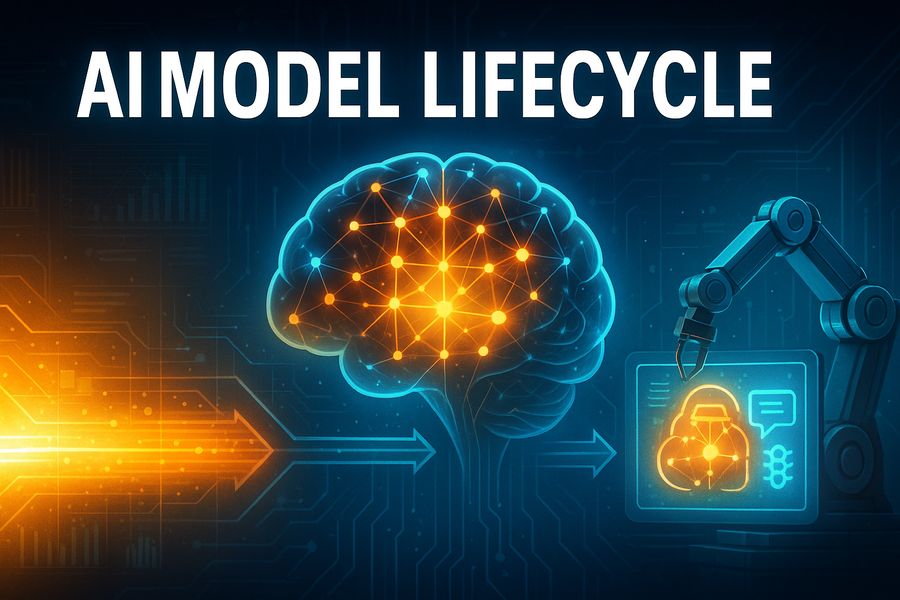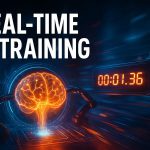Artificial Intelligence (AI) is not just about clever algorithms — it’s about bringing those algorithms to life in real-world applications. Behind every intelligent chatbot, recommendation engine, or autonomous vehicle lies a journey: the AI model lifecycle.
In this article, we’ll explore the end-to-end journey of an AI model — from data collection and training to testing, deployment, and continuous monitoring in production. 🌱➡️🌳
📥 1. Data Collection and Preprocessing 🧹
Every AI model starts with data — the raw fuel that powers learning. But data is rarely clean or structured in the beginning.
🔍 Key Steps:
-
Data Sourcing: Collecting data from sensors, databases, APIs, or user interactions.
-
Data Cleaning: Removing duplicates, handling missing values, and filtering noise.
-
Data Labeling: Annotating data for supervised learning (e.g., image classification).
-
Normalization: Scaling data for efficient learning.
-
Splitting: Dividing into training, validation, and test sets.
🧠 Why it matters: Poor data = poor model. The quality and relevance of your data directly impact the final output. Garbage in, garbage out! 🗑️➡️🧠
🏗️ 2. Model Design and Architecture Selection 🧠
Once data is ready, the next step is choosing the right model architecture.
🤔 Options Include:
-
Linear models for simple tasks.
-
Decision trees for classification.
-
Convolutional Neural Networks (CNNs) for image processing.
-
Transformers for natural language tasks (like ChatGPT).
-
Reinforcement Learning for agents interacting with environments.
Engineers consider:
-
Task complexity 📈
-
Dataset size 📊
-
Inference speed requirements ⏱️
-
Deployment constraints 🧮
🔧 Model design is like choosing the right engine for your car — it depends on where you’re driving and how fast you want to go.
🧪 3. Training the Model 🏋️♂️
With the architecture defined, it’s time to train the model — where it learns patterns from data.
🔁 What Happens:
-
The model makes predictions and compares them to actual results.
-
The loss function measures how far off the predictions are.
-
Backpropagation and gradient descent adjust weights to minimize loss.
-
This process repeats for many epochs (iterations over the dataset).
⚙️ Key Tools:
-
Frameworks like TensorFlow, PyTorch, or JAX.
-
Accelerators like GPUs and TPUs.
-
Hyperparameters like learning rate, batch size, and dropout rate are tuned for optimal performance.
📊 Training can take from minutes to weeks, depending on model size and data volume.
📏 4. Evaluation and Testing ✅
Before deploying a model, it must be evaluated rigorously to ensure it’s accurate, fair, and reliable.
Metrics to Consider:
-
Accuracy, Precision, Recall, and F1 Score for classification.
-
RMSE or MAE for regression.
-
AUC-ROC for model discrimination.
-
Bias and fairness assessments to ensure ethical behavior.
Testing involves:
-
Using a validation set during training to tune parameters.
-
Applying a test set post-training to evaluate generalization.
-
Cross-validation for robustness.
🔬 Evaluation is your AI model’s final exam before it graduates to real-world application!
📦 5. Deployment: Going from Lab to Live 🌐
Deployment is the bridge between experimentation and real-world impact. It involves packaging the trained model and integrating it into applications.
Deployment Options:
-
Cloud-based APIs (e.g., AWS SageMaker, Azure ML, Google Vertex AI).
-
Edge deployment for low-latency (e.g., smartphones, IoT devices).
-
Containers (Docker, Kubernetes) for scalable environments.
Important aspects:
-
Model Serving: Making predictions via APIs or batch processes.
-
Latency Optimization: Ensuring fast inference times.
-
Versioning: Keeping track of model versions and rollbacks.
📦 This stage turns a trained model into a usable tool — ready to serve users or power systems.
🔍 6. Monitoring and Maintenance 🛠️
AI doesn’t stop working after deployment. Models must be monitored continuously to ensure they remain accurate and relevant.
What to Watch:
-
Model Drift: When data patterns change over time.
-
Performance Degradation: Gradual loss in accuracy.
-
Data Drift: Input data changes from training data.
-
Latency and Throughput: Monitoring system health and responsiveness.
Tools Used:
-
Prometheus and Grafana for real-time monitoring.
-
MLOps platforms like MLflow, Kubeflow, and Seldon.
🔄 AI is not a set-it-and-forget-it system — it’s a living component that needs care and updates.
♻️ 7. Retraining and Feedback Loops 🔁
Feedback from real-world usage is gold. It helps improve the model through retraining and continuous learning.
Continuous Learning Pipeline:
-
Collect new data and user feedback.
-
Integrate it into the dataset.
-
Retrain or fine-tune the model.
-
Test and redeploy.
🔄 This cycle allows the model to adapt to new patterns, regulations, and user needs over time.
💬 Think of this as the AI learning from its mistakes and growing smarter with experience — just like a human!
🔐 Ethics, Governance, and Compliance 📜
Throughout the lifecycle, AI systems must adhere to ethical standards and legal requirements.
Key Considerations:
-
Bias Mitigation: Avoiding harmful stereotypes.
-
Explainability: Making model decisions interpretable.
-
Regulatory Compliance: GDPR, HIPAA, and AI Acts.
-
Security: Protecting models from adversarial attacks or leaks.
🌍 Responsible AI ensures technology benefits society without causing unintended harm.
🚀 Conclusion: The Lifecycle in Action
From collecting data to deploying intelligent applications, the AI model lifecycle is a multi-phase journey that blends science, engineering, ethics, and operations. Here’s a quick recap:
-
Data Preparation 🧹
-
Model Design 🧠
-
Training 🏋️
-
Evaluation ✅
-
Deployment 🌐
-
Monitoring 🔍
-
Retraining 🔁
Each step is crucial for building trustworthy, scalable, and impactful AI systems. Whether you’re a data scientist, software engineer, or business leader, understanding this lifecycle is essential in today’s AI-driven world. 🌟


